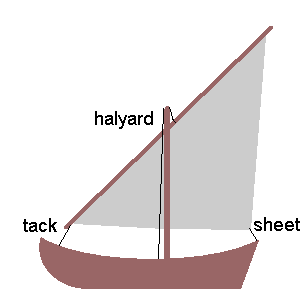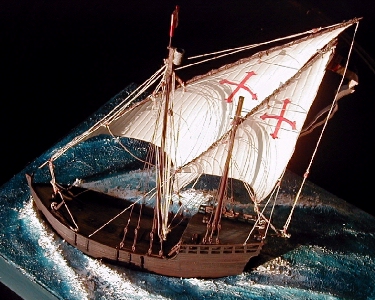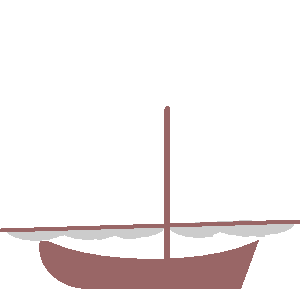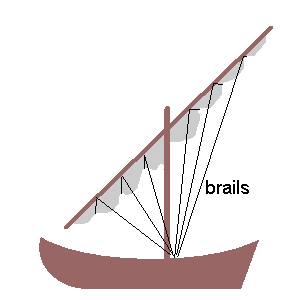Ship Modelling
Rigging Patterns - The Lateen Rigging

 The pattern of a simple lateen rigging, and my Heller model of the caravel Niña, that I built around 1985. The various reconstructions of the Niña show her with 2 or 3 lateen rigged masts, each having one sail only. The Lateen rigging, most widely used in the Mediterranian in a variety of ship types in any historical era, is very simple: a single sail on the mast; one heavy halyard for hoisting the lateen yard diagonally, a tack at the lateen yards foot end and a flying sheet at the sail corner - 3 lines only per sail. The sail could be taken in (up) by additional brails or by taking the entire yard down on deck, which is the most common method. The strain force of the sail was always to the sides of the ship, thus many shrouds for the mast, giving it stability to fore and aft equally but mostly to the sides. Astonishingly, there seem not to have been any stays as on square standing rigging; that indicates that the sail was not used for sailing large, but more abeam or closed to the wind. A small lateen sail has all the flexibility to be used in any setting. But a bigger lateen sail has a special behavior: the lateen yard is so long - even longer than the mast itself! - that it cannot be "swapped" to the other side of the mast; as it is hoisted on the side of the mast, it can be filled with wind fully on one side only. When the wind comes from the opposite side, the wind "folds" the sail onto the mast. There had been speculations about how the lateen yard had been used in altering winds. Due to its length, it was hardly possible to take in the foot yard arm behind the mast, in order to swap the side. What might have been possible was to swing the entire yard around, so that the foot yard arm then is on the aft rather than to the fore; while some depictions seem to proove that, it is also (to my mind much more) likely that the lateen yard never was swung around at all, but that it was an easy and accepted method to let the sail "fold" around the mast and maybe also its shrouds - that was then a kind of "wooden sheet" in the middle of the sail, and using this method, it was most easy to go about as well as to gibe. Also, the lateen sail could be swung a half turn and being used like a square sail, to go large, before the wind. Given all these experiences, it is striking how any other sail could be considered when the lateen sail was so univeral and easy in usage. A Hoisted or A Fixed Lateen YardBoth types were and still are in use.
The Lateen Mizzen Sail on Square RiggersBetween 1400 and 1800, virtually all sailing ships had a lateen sail on their mizzen masts, that was the standard rigging.After that era, the mizzen became the "spanker", the fore part of the yard and the sail were cut and the sail could swing ("spank") easier then. Some big carracks and galleons around 1600 had even top lateen sails; their handling is subject of maritime research, it must have been very difficult to steer such a sail in the tops ... In 2009, I had the luck to see it in reality onboard the Swedish replica of the East-Indiaman "Götheborg": the lateen yard, hoisted to the port side of the mizzen mast, was never lowered, the sail was taken in by brails only. By using the sheets and the tacks, the lateen yard was swung only slightly, no matter if the wind came from port or starboard; the wind from portside "folded" it around the mizzen mast. But also, as the sail was set between the mast and the shrouds, the wind from starboard folded the sail around the port shrouds, so that sailors could only go aloft on starboard then (which is the standard secure way, to go aloft on those shrouds where the wind comes from). When sailing large (wind coming from the back), the lateen mizzen on a square rigger is of no use and not set. But even when the course is abeam or closed to the wind, the lateen mizzen only has an additional steering function and is often not used. Instead, the "opposite" of the Lateen sails, the square sails were most efficient in this situation. |


